|
|
 |
|
Calanoida ( Order ) |
|
|
|
Diaptomoidea ( Superfamily ) |
|
|
|
Acartiidae ( Family ) |
|
|
|
Acartia ( Genus ) |
|
|
|
Acartia ( Sub-Genus ) |
|
|
| |
Acartia (Acartia) negligens Dana, 1849 (F,M) | |
| | | | | | | Syn.: | Acartia neglecta Car & Hadzi, 1914 a;
Acartia (Planktacartia) negligens : Rose, 1929 (p.48); Vervoort, 1965 (p.196, Rem.); Kos, 1972 (Vol. I, figs.F, M, Rem.); Phukham, 2008 (p.57, figs.F); W.-B. Chang & al., 2010 (p.735, Table 2, abundance); Tseng & al., 2012 (p.621, Table 3: abundance); Tseng & al., 2013 (p.507, seasonal abundance).
| | | | Ref.: | | | Giesbrecht, 1892 (p.508, 522, 770, figs.F); Giesbrecht & Schmeil, 1898 (p.154); A. Scott, 1909 (p.188, Rem.); Wolfenden, 1911 (p.357); Sewell, 1914 a (p.241); Pesta, 1920 (p.548); Steuer, 1923 (p.35, figs.F,M); Früchtl, 1924 b (p.61); Sars, 1925 (p.362); Rose, 1929 (p.48); Farran, 1929 (p.210, 281); Sewell, 1932 (p.397); Rose, 1933 a (p.277, figs.F,M); Farran, 1936 a (p.122); Mori, 1937 (1964) (p.101, figs.F,M); Moore, 1949 (p.61); Chiba & al., 1957 (p.310); 1957 a (p.12); Tanaka, 1960 (p.55, fig.F); Fish, 1962 (p.20); Grice, 1962 (p.240, fig.F); Tanaka, 1964 (p.13); Chen & Zhang, 1965 (p.114, figs.F); Tanaka, 1965 (p.394, figs.F,M); Owre & Foyo, 1967 (p.101, figs.F,M); Vidal, 1968 (p.47, figs.F,M); Park, 1968 (p.569, figs.M, Rem.); Corral Estrada, 1970 (p.207); Ramirez, 1971 (p.89, fig.F); Razouls, 1972 (p.95, Annexe: p.100); Crisafi & Crescenti, 1972 (1974) (p.234, figs.F,M, juv.); Björnberg, 1972 (p.73, figs., Rem.N); Goswami & Goswami, 1973 (p.242, fig.1, karyotype); Marques, 1974 (p.19, fig.F); 1976 (p.998); Dawson & Knatz, 1980 (p.8, figs.F,M); Marques, 1982 (p.767); Greenwood, 1978 (p.13, figs.F,M, Rem.); Yoo & Hue, 1983? (p.11, figs.F); Sazhina, 1985 (p.82, figs.N); Yoo & al., 1991 (p.258); Chihara & Murano, 1997 (p.669, Pl.17: F,M); Bradford-Grieve, 1999 (N°181, p.6, figs.F,M); Bradford-Grieve & al., 1999 (p.886, 962, figs.F,M); Barthélémy, 1999 (p.858, 864, figs.F); 1999 a (p.9, Fig.25, G, H); Bradford-Grieve, 1999 b (p.220, figs.F,M, Rem., figs.186, 195); Conway & al., 2003 (p.103, figs.F,M, Rem.); Mulyadi, 2004 (p.144, figs.F, Rem.); Avancini & al., 2006 (p.116, Pl. 84, figs.F,M, Rem.); Vives & Shmeleva, 2007 (p.425, figs.F,M, Rem.). | 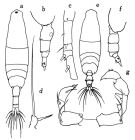 issued from : O. Tanaka in Publs Seto Mar. Biol. Lab., 1965, XII (5). [p.394, Fig.249]. As Acartia (Planktacartia) negligens)Female: a, habitus (dorsal); b, last thoracic segment and urosome (right lateral side); c, proximal portion of A1, d, P5. Male: e, habitus (dorsal); f, last thoracic segment and urosome (right lateral side); g, P5. Nota: In the urosome the 1st segment has a tuft of short hairs on each side of the lateral margin; 2nd segment has, beside the tuft of hairs on the lateral distal margin, a row of minute spinules on the dorsal distal margin; 3rd segment has 4 minute spinules near the dorsal distal margin.
|
 Issued from : T.S. Park in Fishery Bull. Fish Wild. Serv. U.S., 1968, 66 (3). [p.568, Pl.13, Figs.17-18]. Male: 17, posterior part of the last thoracic segment and urosome (dorsal); 18, P5.
|
 issued from : J.M. Bradford-Grieve in The Marine Fauna of New Zealand: Pelagic Calanoid Copepoda. National Institute of Water and Atmospheric Research (NIWA). NIWA Biodiversity Memoir, 111, 1999. [p.221, Fig.163].
Male: E, habitus (dorsal); F, urosome (dorsal); G, P5 (L = left leg; R = right leg).
Nota: The posterior body from the Southwest Pacific appears to be more decorated than the Steuer's (1923) description.
|
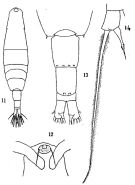 issued from: Q.-c Chen & S.-z. Zhang in Studia Marina Sinica, 1965, 7. [Pl.50, 11-14]. Female (from E China Sea): 11, habitus (dorsal); 12, forehead (ventral); 13, urosome (dorsal); 14, left P5 (posterior).
|
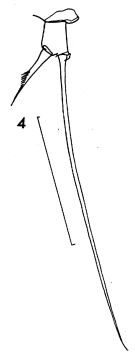 issued from : F.C. Ramirez in Revta Mus. La Plata, Seccion Zool., 1971, XI. [Lam.III, Fig.4]. Female (from off Mar del Plata): 4, P5. Scale bar in mm: 1.2.
|
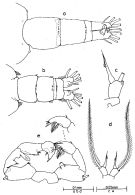 issued from : J.G. Greenwood in Proc. R. Soc. Qd, 1978, 89. [p.14, Fig.6]. Female (from Moreton Bay, E Australia): a, postrior metasome and urosome (dorsal); c, P5 with outer ramus truncated; d, P5. Male: b, posterior metasome and urosome (dorsal); e, P5.
|
 issued from : W. Giesbrecht in Fauna Flora Golf. Neapel, 1892, 19. [Taf.30, Fig.12]. Female: 12, Md (mandibular edge).
|
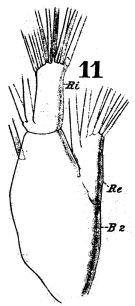 issued from : W. Giesbrecht in Fauna Flora Golf. Neapel, 1892, 19. [Taf.30, Fig.11] Female: 11, Md (mandibular palp).
|
 issued from : W. Giesbrecht in Fauna Flora Golf. Neapel, 1892, 19. [Taf.30, Fig.22]. Female: 22, P5.
|
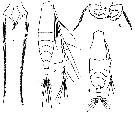 issued from : T. Mori in The pelagic Copepoda from the neighbouring waters of Japan, 1937 (2nd edit., 1964). [Pl.49, Figs.1-4]. Female: 1, P5; 2, habitus (dorsal). Male: 3, P5; 4, habitus (dorsal).
|
 issued from : C. Razouls in Th. Doc. Etat Fac. Sc. Paris VI, 1972, Annexe. [Fig.56, A, G]. Female (from Banyuls, G. of Lion): C, P5.
|
 issued from : C. Razouls in Th. Doc. Etat Fac. Sc. Paris VI, 1972, Annexe. [Fig.57, C]. Male: P5.
|
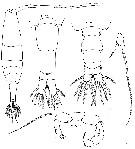 issued from : P. Crisafi & M. Crescenti in Boll. Pesca Piscic. Idrobiol., 1972 (1974), 27 (2). [p.252, Pl.XII]. Female (from Milazzo, Sicily): f, habitus (dorsal); f ad, posterior thoracic part and urosome (dorsal); f P2, P2. Male: m ad, posterior thoracic part and urosome (dorsal); m P5, P5.
|
 issued from : R.-M. Bathélémy in J. Mar. Biol. Ass. U.K., 1999, 79. [p.863, Fig.6, G-H]. Scanning electon miccrograph. Female (from N Atlantic Ocean): G, genital double-somite (ventral) with lateroventral genital structures (arrows); H, detail of the right genital slit with a median cuticular lamella (arrow) and copulatory pore (cp). Scale bars: 0.020 mm (G); 0.005 mm (H).
Symbols: a = gonoporal field; b, copulatory field.
|
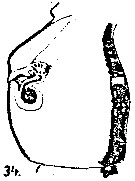 issued from : A. Steuer in Arb. zool. Inst. Innsbruck, 1923, 1 (5). [Taf. IV, Fig.34]. Female: 34, genital segment (lateral).
|
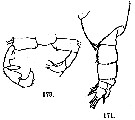 issued from : A. Steuer in Arb. zool. Inst. Innsbruck, 1923, 1 (5). [p.36, Figs.171, 173]. Male: 171, last thoracic segment and urosome (dorsolateral); 173, P5.
|
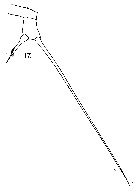 issued from : G.D. Grice in Fish. Bull. Fish and Wildl. Ser., 1962, 61. [p.238, Pl.34, Fig.17]. Female (from equatorial Pacific); 17, P5. In contradiction to A. danae, the posterior lateral margins of the last thoracic segment have a series of very small points. The external seta of P5 is more than 4 times the length of the internal spine.
|
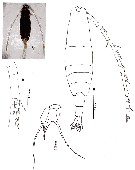 issued from : N. Phukham in Species diversity of calanoid copepods in Thai waters, Andaman Sea (Master of Science, Univ. Bangkok). 2008. [p.141, Fig.15]. Female (from W Malay Peninsula): a, habitus (dorsal); b, segments of A1; c, P5. Body length after the drawings: F: = 1.020 mm.
|
 issued from : Mulyadi in Published by Res. Center Biol., Indonesia Inst. Sci. Bogor, 2004. [p.145, Fig.82]. Female (from Indonesian Seas): a, habitus (dorsal); b, posterior part of last thoracic segment with P5 and urosome (lateral right side); c, same (dorsal); d, A1; e, P5.
|
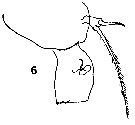 Issued from : O. Tanaka in Spec. Publs. Seto mar. biol. Lab., 10, 1960 [Pl. XXIV, 6]. Female (from Indian Ocean): 6, last thoracic segment and genital segment (lateral). Nota: Cephalothorax and abdomen in the proportional lengths 75 to 25. Rostal filament absent. Postero-lateral margin of the thoracic segment broadly rounded and slightly sinuate, with 2 small spines and short hairs on the distal margin. P5: terminal claw fusnished with small denticles: the outer marginal seta very long, more than 5 times as long as the distal segment.
|
 Issued from : M. Chihara & M. Murano in An Illustrated Guide to Marine Plankton in Japan, 1997. [p.675, Pl. 17, fig.3 a-d]. Female: a, habitus (dorsal); b, forehead (part., ventral) and proximal segment of A1; c, last thoracic segment and urosome (dorsal); d, P5. Nota: numbers show characteristics of this species to compare with A. danae.
|
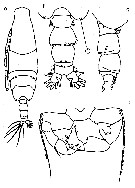 Issued from : M. Chihara & M. Murano in An Illustrated Guide to Marine Plankton in Japan, 1997. [p.675, Pl. 17, fig.3 e-h]. Male: e, habitus (dorsal); f, last thoracic segment and urosome (dorsal); g, same (lateral, right side); h, P5. Nota: numbers show characteristics of this species to compare with A. danae.
|
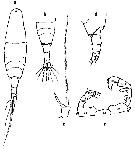 Issued from : M.G. Mazzocchi in Guida al Riconoscimento del plancton dei Mari Italiani, Vol. II, 2006. [p.92, Tav. 84]. After A. Comaschi. Female: a, habitus (dorsal); b, posterior part of Prosome and urosome (dorsal); c, right P5. Male: d, last thoracic segment and urosome (lateral); e, P5.
| | | | | Compl. Ref.: | | | Thompson & Scott, 1903 (p.236, 254); Carl, 1907 (p.17); Rose, 1925 (p.152); Wilson, 1942 a (p.169); Massuti Alzamora, 1942 (p.99, Rem.); Sewell, 1948 (p.392, 461); C.B. Wilson, 1950 (p.155); Yamazi, 1958 (p.153, Rem.); Ganapati & Shanthakumari, 1962 (p.9, 15); Fagetti, 1962 (p.37); Gaudy, 1962 (p.93, 99, Rem.: p.115) ; Duran, 1963 (p.25); V.N. Greze, 1963 a (tabl.2); Shmeleva, 1963 (p.141); Ahlstrom & Thrailkill, 1963 (p.57, Table 5, abundance); Gaudy, 1963 (p.29, Rem.); Björnberg, 1963 (p.63, Rem.); De Decker, 1964 (p.14, 17, 27); De Decker & Mombeck, 1964 (p.11); Grice & Hulsemann, 1965 (p.225); Shmeleva, 1965 b (p.1350, lengths-volume -weight relation); Pavlova, 1966 (p.44); Mazza, 1966 (p.73); 1967 (p.361: Rem.); Furuhashi, 1966 a (p.295, vertical distribution vs mixing Oyashio/Kuroshio region, Table 8, 9); Grice & Hulsemann, 1967 (p.20); Fleminger, 1967 a (tabl.1); Evans, 1968 (p.11); Vinogradov, 1968 (1970) (p.78); De Decker, 1968 (p.45); Delalo, 1968 (p.138); Champalbert, 1969 a (p.616); El-Maghraby & Dowidar, 1970 (p.81); Dowidar & El-Maghraby, 1970 (p.267); Itoh, 1970 (tab.1); Timonin, 1971 (p.281, trophic group); Deevey, 1971 (p.224); Binet & al., 1972 (p.71); Roe, 1972 (p.277, tabl.1, tabl.2); Apostolopoulou, 1972 (p.329, 371, fig.8); Guglielmo, 1973 (p.399); Heinrich, 1973 (p.95); Björnberg, 1973 (p.353, 384); Corral Estrada & Pereiro Muñoz, 1974 (tab.I); Richman & al., 1975 (p.918, feeding); Timonin, 1976 (p.79, vertical distribution); Deevey & Brooks, 1977 (p.156, tab.2, Station "S"); Tranter, 1977 (p.596); Madhu Pratap & al., 1977 (p.138, Table 3: abundance vs. stations); Carter, 1977 (1978) (p.36); Timonin & Voronina, 1977 (p.292, fig.8); Svetlichnyi, 1980 (p.28, Table 1, passive submersion); Star & Mullin, 1981 (p.1322, abundance); Sreekumaran Nair & al., 1981 (p.493), Rudyakov, 1982 (p.208, Table 2); Vives, 1982 (p.295); Kovalev & Shmeleva, 1982 (p.85); Smith S.L., 1982 (p.1331, abundance, monsoon effect); Dessier, 1983 (p.89, Tableau 1, 2, Rem., %); Guangshan & Honglin, 1984 (p.118, tab.); Scotto di Carlo & al., 1984 (1045); De Decker, 1984 (p.317, 327: carte); Binet, 1984 (tab.3); 1985 (p.85, tab.3); Regner, 1985 (p.11, Rem.: p.39); Almeida Prado Por, 1985 (p.250); Greze & al., 1985 (p.8); Moraitou-Apostolopoulou, 1985 (p.303, occurrence/abundance in E Mediterranean Sea); Brenning, 1985 a (p.28, Table 2); Madhupratap & Haridas, 1986 (p.105, tab.2); Brinton & al., 1986 (p.228, Table 1); Renon, 1987 (tab.2); Brenning, 1987 (p.34, Rem.); Jimenez-Perez & Lara-Lara, 1988; Dessier, 1988 (tabl.1); Lozano Soldevilla & al., 1988 (p.60); Hirakawa & al., 1990 (tab.3); Madhupratap & Haridas, 1990 (p.305, fig.4: vertical distribution night/day; fig.7: cluster); Yoo, 1991 (tab.1); Echelman & Fishelson, 1990 a (tab.2); McKinnon, 1991 (p.471); Heinrich, 1995 (tab.1); Shih & Young, 1995 (p.66); Padmavati & Goswami, 1996 a (p.85, fig.2, 3, Table 4, vertical distribution); Madhupratap & al., 1996 (p.866); Go & al., 1997 (tab.1, as Acarita negiligens: lapsus calami); Park & Choi, 1997 (Appendix); Padmavati & al., 1998 (p.349); Alvarez-Cadena & al., 1998 (tab.2); Hwang & al., 1998 (tab.II); Noda & al., 1998 (p.55, Table 3, occurrence); Wong & al, 1998 (tab.2); Hsieh & Chiu, 1998 (tab.2); Suarez-Morales & Gasca, 1998 a. (p107); Smith S. & al., 1998 (p.2369, Table 6, moonsoon effects); Mauchline, 1998 (tab.8, 58, 64); Hure & Krsinic, 1998 (p.73, 103); Siokou-Frangou, 1999 (p.478); Dolganova & al., 1999 (p.13, tab.1); Lavaniegos & Gonzalez-Navarro, 1999 (p.239, Appx.1); Moraitou-Apostolopoulou & al., 2000 (fig.7); El-Sherif & Aboul Ezz, 2000 (p.61, Table 3: occurrence); Ueda & al., 2000 (tab.1); Madhupratap & al., 2001 (p. 1345, vertical distribution vs. O2, figs.4, 5: clusters, p.1353); Suarez-Morales & Morales-Ramirez, 2001 (p.1286); Belmonte & Potenza, 2001 (p.174); El-Serehy & al., 2001 (p.116, Table 1: abundance vs transect in Suez Canal); Lo & al., 2001 (p.1139, tab.I); Vukanic, 2003 (p.139, tab.1); Hwang & al., 2003 (p.193, tab.2); Shimode & Shirayama, 2004 (p.607, tab.1, 2); Hsiao & al., 2004 (p.325, tab.1); Hsieh & al. 2004 (p.396, tab. 1, p.399, tab. 2); Lan & al., 2004 (p.332, tab.1); Lo & al.*, 2004 (p.218, fig.6); Lo & al., 2004 (p.89, tab.1); Gallienne & al., 2004 (p.5, tab.3); Wang & Zuo, 2004 (p.1, Table 2, dominance, origin); Vaglio & al., 2005 (p.163); Berasategui & al., 2005 (p.313, fig.2); Obuid Allah & al., 2005 (p.123, occurrence % vs metal contamination); Zuo & al., 2006 (p.163: tab.1); Hwang & al., 2006 (p.943, tab.I); Lavaniegos & Jiménez-Pérez, 2006 (p.135, tab.2, 4, Rem.); Khelifi-Touhami & al., 2007 (p.327, Table 1); Cornils & al., 2007 (p.278, Table 2); Hwang & al., 2007 (p.23); Dur & al., 2007 (p.197, Table IV); McKinnon & al., 2008 (p.843: Tab.1); Jitlang & al., 2008 (p.65, Table 1); Humphrey, 2008 (p.83: Appendix A); Neumann-Leitao & al., 2008 (p.799: Tab.II, fig.6); Morales-Ramirez & Suarez-Morales, 2008 (p.512, 517); Fernandes, 2008 (p.465, Tabl.2); Raybaud & al., 2008 (p.1765, Table A1); Ayon & al., 2008 (p.238, Table 4: Peruvian samples); Muelbert & al., 2008 (p.1662, Table 1); Tseng L.-C. & al., 2008 (p.153, Table 2, fig.5, occurrence vs geographic distribution, indicator species); Tseng & al., 2008 (p.402, Table 2); Pagano, 2009 (p.116); C.-Y. Lee & al., 2009 (p.151, Tab.2); Skovgaard & Salomonsen, 2009 (p.425); Tseng & al., 2009 (p.327, fig.5, feeding); C.E. Morales & al., 2010 (p.158, Table 1); Brugnano & al., 2010 (p.312, Table 2, 3); Cornils & al., 2010 (p.2076, Table 3); Schnack-Schiel & al., 2010 (p.2064, Table 2: E Atlantic subtropical/tropical); Mazzocchi & Di Capua, 2010 (p.423); Nowaczyk & al;, 2011 (p.2159, Table 2); Hsiao S.H. & al., 2011 (p.475, 481: indicator species, Appendix I); Kang J.-H., 2011 (p.219, occurrences, inter-annual variability vs t° & Sal., Chl.a, Rem.: p.428); Andersen N.G. & al., 2011 (p.71, Fig.3: abundance); Maiphae & Sa-ardrit, 2011 (p.641, Table 2); Selifonova, 2011 a (p.77, Table 1, alien species in Black Sea); El-Sherbiny & al., 2011 (p.837, seasonal abundance), Mazzocchi & al., 2011 (p.1163, fig.6, long-term time-series 1984-2006); Kâ & Hwang, 2011 (p.155, Table 3: occurrence %); Tseng L.-C. & al., 2011 (p.47, Table 2, occurrences vs mesh sizes); Uysal & Shmeleva, 2012 (p.909, Table I); DiBacco & al., 2012 (p.483, Table S1, ballast water transport); Tseng & al., 2012 (p.621, Table 3: abundance); Mazzocchi & al., 2012 (p.135, annual abundance 1984-2006); Hidalgo & al., 2012 (p.134, Table 2); Tseng & al., 2013 a (p.1, Table 3, 4, abundance); Gubanova & al., 2013 (in press, p.4, Table 2); Belmonte & al., 2013 (p.222, Table 2, abundance vs stations); in CalCOFI regional list (MDO, Nov. 2013; M. Ohman, pers. comm.); Beyrend-Dur, 2013 (p.771, fig.6: composition); Hirai & al., 2013 (p.1, Table I, molecular marker); Lidvanov & al., 2013 (p.290, Table 2, % composition); El-Serehy & al., 2013 (p.2099, Rem.: p.2101); Oh H.-J. & al., 2013 (p.192, Table 1, occurrence); Hwang & al., 2014 (p.43, Appendix A: seasonal abundance); Pansera & al., 2014 (p.221, Table 2, abundance); Mazzocchi & al., 2014 (p.64, Table 5, abundance); Zakaria, 2014 (p.3, Table 1, abundance vs 1960-2000); Zakaria & al., 2016 (p.1, Table 1); Benedetti & al., 2016 (p.159, Table I, fig.1, functional characters); Ben Ltaief & al., 2017 (p.1, Table III, Summer relative abundance); El Arraj & al., 2017 (p.272, table 2); Benedetti & al., 2018 (p.1, Fig.2: ecological functional group); Abo-Taleb & Gharib, 2018 (p.139, Table 5, occurrence %); Belmonte, 2018 (p.273, Table I: Italian zones); Palomares-Garcia & al., 2018 (p.178, Table 1: occurrence); Acha & al., 2020 (p.1, Table 3: occurrence % vs ecoregions). | | | | NZ: | 17 | | |
|
Distribution map of Acartia (Acartia) negligens by geographical zones
|
| | | | | | | | | | | |  Chart of 1996 Chart of 1996 | |
 issued from : A.A. Shmeleva in Bull. Inst. Oceanogr., Monaco, 1965, 65 (n°1351). [Table 6: 37]. Acartia negligens (from South Adriatic). issued from : A.A. Shmeleva in Bull. Inst. Oceanogr., Monaco, 1965, 65 (n°1351). [Table 6: 37]. Acartia negligens (from South Adriatic).
Dimensions, volume and Weight wet. Means for 50-60 specimens. Volume and weight calculated by geometrical method. Assumed that the specific gravity of the Copepod body is equal to 1, then the volume will correspond to the weight. |
 Issued from : M.G. Mazzocchi, L. Dubroca, C. Garcia-Comas, I. Di Capua & M. Ribera d'Alcalà in Progr. Oceanogr., 2012, 97-100. [p.143, Fig.10]. Issued from : M.G. Mazzocchi, L. Dubroca, C. Garcia-Comas, I. Di Capua & M. Ribera d'Alcalà in Progr. Oceanogr., 2012, 97-100. [p.143, Fig.10].
Long-term variability of the abundance (Ind. m3) of rare copepod species that appeard in 1995 and occurred regularly starting from 1998 (autumn-winter) at Station MC (Gulf of Naples), by vertical tows in the upper 50 m. |
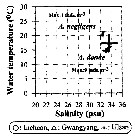 Issued from : J.-H. Kang in Ocean Sci. J., 2011, 46 (4). [p.228, Fig.5] Issued from : J.-H. Kang in Ocean Sci. J., 2011, 46 (4). [p.228, Fig.5]
Abundance-temperature-salinity diagram of A. negligens observed in the seaports from Korea during 3 years (2007-2009). |
 Issued from : J.-H. Kang in Ocean Sci. J., 2011, 46 (4). [p.229, Fig.6] Issued from : J.-H. Kang in Ocean Sci. J., 2011, 46 (4). [p.229, Fig.6]
Abundance-total suspended solid-chlorophyll-a diagram of A. negligens observed in the seaports from Korea during 3 years (2007-2009). |
 Issued from : J.-H. Kang in Ocean Sci. J., 2011, 46 (4). [p.230, Fig.7] Issued from : J.-H. Kang in Ocean Sci. J., 2011, 46 (4). [p.230, Fig.7]
Abundance-dissolved oxygen-chlorophyll-a diagram of A. negligens observed in the seaports from Korea during 3 years (2007-2009). |
 Issued from : M. Madhupratap & P. Haridas in J. Plankton Res., 12 (2). [p.311, Fig.4]. Issued from : M. Madhupratap & P. Haridas in J. Plankton Res., 12 (2). [p.311, Fig.4].
Vertical distribution of calanoid copepod (mean +1 SE), abundance No/100 m3. 23- Acartia negligens.
Night: shaded, day: unshaded.
Samples collected from 6 stations located off Cochin (India), SE Arabian Sea, November 1983, with a Multiple Closing Plankton Net (mesh aperture 300 µm), in vertical hauls at 4 depth intervalls (0-200, 200-400, 400-600, 600-1000 m). |
 Issued from : M. Madhu Pratap, M.V.M. Wafar, P. Haridas, B. Narayanan, Gopala Menon P. & Narayanan B. inIndian J. Mar. Sci., 1977, 6. [p.140, Table 3]. Issued from : M. Madhu Pratap, M.V.M. Wafar, P. Haridas, B. Narayanan, Gopala Menon P. & Narayanan B. inIndian J. Mar. Sci., 1977, 6. [p.140, Table 3].
Table 3 part.: Composition and distribution of copepods at different stations from Laksshadweep group of islands in the sea surrounding atolls compared to lagoons (Kavaratti : 10°35'N, 72°36'E; Agatti: 10°51'N, 72°11'E: Suhelipar: 10°04'N, 72°15'E.
Samples taken with net (mesh aperture 300µm), surface hauls taken during 10 min, day time, in December 1976.
Species diversity were calculated using three indices (Fisher & al.1943; Margalef, 1960; Shannon & Weaver, 1963) for each of the different locations in the sea surrounding atolls compared to lagoons.
Only four species of copepods shown in the Table 3 on total 23 species + 7 spp. |
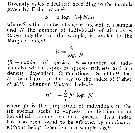 Issued from : M. Madhu Pratap, M.V.M. Wafar, P. Haridas, B. Narayanan, Gopala Menon P. & Narayanan B. inIndian J. Mar. Sci., 1977, 6. [p.139]. Issued from : M. Madhu Pratap, M.V.M. Wafar, P. Haridas, B. Narayanan, Gopala Menon P. & Narayanan B. inIndian J. Mar. Sci., 1977, 6. [p.139].
Diversity index used.
11: Fischer & al., 1943. J. Anim. Ecol., 12: 42-58; Margalef, 1960. In Perspectives in marine biology, Buzzati Traverso (ed), Univ. of California Press, 323.
14: Shannon & Weaver, 1963. The mathematical theory of communication. Univ. Illinois Oress, Urbana. 117. 15: Livingston, 1976. Estuar. Coast. Mar. Sci., 373. |
| | | | Loc: | | | sub-Antarct., South Africa (off Cape of Good Hope, E & W), off E Tristan da Cunha, off SE Ste Hélène Is., Ascension Is., off E St. Paul Is., Ivorian shelf, Dakar, Argentina, Uruguay (continental shelf) Brazil, off Amazon, off Morocco-Mauritania, Canary Is., off Madeira, Azores, Barbada Is., Yucatan (Ascension Bay), Caribbean Sea, Sargasso Sea, off Bermuda (Station "S"), Ibero-moroccan Bay, Medit. (Alboran Sea, Algier, G. of Annaba, NW, Castellon, Banyuls, Marseille, Ligurian Sea, Lake Faro, Tyrrhenian Sea, G. of Naples, Milazzo, Gulf of Taranto, G. of Gabes, Malta, Adriatic Sea, Ionian Sea, Aegean Sea, Black Sea, Lebanon Basin, W Egyptian coast, Alexandria), Suez Canal, Lake Timsah, G. of Suez, Sharm El-Sheikh, Safâga, Hurghada, G. of Aqaba, Red Sea, G. of Aden, Arabian Sea, Somalia, Natal, off Madagascar (SE, S), Nosy Bé, Rodrigues Is. - Seychelles, Sri Lanka, Mascarene Basin, Karavatti Is., India (Goa-Gujarat, Mandovi-Zuari estuary, Lawson's Bay), E India, Bay of Bengal, W Malay Peninsula (Andaman Sea), Cilacap Bay (S Java); Ambon Bay, Manado Bay (S Ceram Is.), Australia (North West Cape, G. of Carpentaria), Thaïland, China Seas (South China Sea, East China Sea, Yellow Sea), Hong Kong, Taiwan (S, E, W, N, NW, SW, NE, Danshuei Estuary), Okinawa, S Korea, Ulsan Harbour, Geumo Is., Japan Sea, Japan (Kuchinoerabu Is., Tanabe Bay, Sagami Bay), Tokara Is., off SE Japan, Kuroshio zone, Philippines, Indonesia-Malaysia, Cilacap Bay (S Java), SW Celebes, S Celebes Sea (Manado Bay), Pacif. (tropical), Pacif. (E & W equatorial), Pacif. (N Central Gyre), Australia (Great Barrier, Moreton Bay), Tasman Sea, New Zealand (South Island NE, South Island E, N), off Kermadec Is, Nouvelle-Calédonie, Fiji Is., California, Baja California, G. of California, La paz Hawaii, Clipperton Is., Pacif. (equatorial, central N), W Costa-Rica , off Peru, Chile, off Santiago. | | | | N: | 293 | | | | Lg.: | | | (16) F: 1,18-1,05; M: 1,05-1,01; (34) F: 2,07-1,7; M: 1,5-1,44; (35) F: 1,2-1,1; M: 1,02-0,96; (46) F: 1,27-1,04; (66) F: 1,27-1,06; M: 1,2-1,1; (72) F: 1,3-1,22; M: 1,18; 1,15; (101) F: 1,21-1,05; (114) F: 1,19; (119) F: 1,2-1,09; M: 0,946; (164) F: 1,264-0,954; 1,12; 1,04; M: 0,941-0,797; (168) F: 1,372-1,24; M: 1,221-1,165; (199) F: 1,22-1,06; (237) F: 1,15; (290) F: 1,15-1,2; (449) F: 1,27-1,04; (785) F: 1,17-0,91; (786) F: 1,16-1,04; M: 1,04; (866) F: 1,1-1,2; M: 0,9-1; (909) F: 1; (920) F: 1,15; (991) F: 0,98-1,3; M: 0,8-1,18; (1122) F: 1,05; (1230) F: 0,95-1,27; M: 0,79-1,0; {F: 0,91-2,07; M: 0,80-1,50} | | | | Rem.: | Oceanic and littoral, epipelagic. Also mesopelagic. Sargasso Sea: 0-500 m (Deevey & Brooks, 1977, Station "S").0-820 m at Station T-1 (E Torui Is., E middle Japan)
Cosmopolitan tropical, subtropical and temperate (limited by latitudes 40° N & S). For Acha & al. (2020) this species is observed on shelfbreak in front of Rio de La Plata (Argentina).
For Itoh (1970 a, fig.2, from co-ordonates) the Itoh's index value from mandibular gnathobase = 1150.
Timonin (1971, p.282) considers the trophic interrelations in the equatorial and tropical Indian Ocean, and divides the plankters into 6 trophic groups from the litterature and the results of studies of mouth-parts structure and intestine content. This species is omnivorous.
For Mulyadi (2004, p.151) this species is an inhabitant of the open ocean (stenohaline marine).
After Benedetti & al. (2018, p.1, Fig.2) this species belonging to the functional group 4 corresponding to small filter feeding herbivorous and mixed feeding omnivorous (mostly broadcasters).
See in DVP Conway & al., 2003 (version 1) | | | Last update : 25/10/2022 | |
| | | | It was found A. negligens female (1.24 mm) below 1300 m depth during the nigh in the north of Cape Verde archipelago (20º54'81N; 21º6.51W) | |
|
|
|
 Any use of this site for a publication will be mentioned with the following reference : Any use of this site for a publication will be mentioned with the following reference :
Razouls C., Desreumaux N., Kouwenberg J. and de Bovée F., 2005-2025. - Biodiversity of Marine Planktonic Copepods (morphology, geographical distribution and biological data). Sorbonne University, CNRS. Available at http://copepodes.obs-banyuls.fr/en [Accessed August 23, 2025] © copyright 2005-2025 Sorbonne University, CNRS
|
|
 |
 |




























